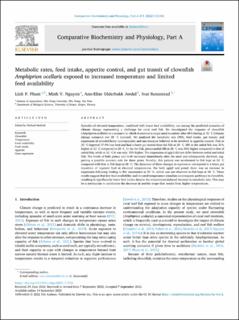| dc.contributor.author | Pham, Phuong Linh | |
| dc.contributor.author | Nguyen, Minh Van | |
| dc.contributor.author | Jordal, Ann-Elise Olderbakk | |
| dc.contributor.author | Rønnestad, Ivar | |
| dc.date.accessioned | 2022-10-25T13:19:36Z | |
| dc.date.available | 2022-10-25T13:19:36Z | |
| dc.date.created | 2022-10-15T13:33:04Z | |
| dc.date.issued | 2022 | |
| dc.identifier.issn | 1095-6433 | |
| dc.identifier.uri | https://hdl.handle.net/11250/3028222 | |
| dc.description.abstract | Episodes of elevated temperature, combined with lower feed availability, are among the predicted scenarios of climate change representing a challenge for coral reef fish. We investigated the response of clownfish (Amphiprion ocellaris) to a scenario in which it received a single meal to satiety after 48 h fasting at 32 °C (climate change scenario) and 28 °C (control). We analysed the metabolic rate (MR), feed intake, gut transit, and expression of selected brain neuropeptides and one receptor believed to be involved in appetite control. Fish at 32 °C ingested 17.9% less feed and had a faster gut transit than did fish at 28 °C. MR in the unfed fish was 31% higher at 32 °C compared to 28 °C. In the fed fish, postprandial MR at 28 °C was 30% higher compared to that of unfed fish, while at 32 °C it was only 15% higher. The expression of agrp1 did not differ between unfed and refed fish. The levels of both pomca and mc4r increased immediately after the meal and subsequently declined, suggesting a possible anorexic role for these genes. Notably, this pattern was accelerated in fish kept at 32 °C compared with that in fish kept at 28 °C. The dynamics of these changes in expression correspond to a faster gut transition of ingested feed at elevated temperatures. For both agrp2 and pomcb there was an increase in expression following feeding in fish maintained at 32 °C, which was not observed in fish kept at 28 °C. These results suggest that low feed availability and elevated temperature stimulate anorexigenic pathways in clownfish, resulting in significantly lower feed intake despite the temperature-induced increase in metabolic rate. This may be a mechanism to ameliorate the decrease in aerobic scope that results from higher temperatures. | en_US |
| dc.language.iso | eng | en_US |
| dc.publisher | Elsevier | en_US |
| dc.rights | Navngivelse 4.0 Internasjonal | * |
| dc.rights.uri | http://creativecommons.org/licenses/by/4.0/deed.no | * |
| dc.title | Metabolic rates, feed intake, appetite control, and gut transit of clownfish Amphiprion ocellaris exposed to increased temperature and limited feed availability | en_US |
| dc.type | Journal article | en_US |
| dc.type | Peer reviewed | en_US |
| dc.description.version | publishedVersion | en_US |
| dc.rights.holder | Copyright 2022 the authors | en_US |
| dc.source.articlenumber | 111318 | en_US |
| cristin.ispublished | true | |
| cristin.fulltext | original | |
| cristin.qualitycode | 1 | |
| dc.identifier.doi | 10.1016/j.cbpa.2022.111318 | |
| dc.identifier.cristin | 2061631 | |
| dc.source.journal | Comparative Biochemistry and Physiology A | en_US |
| dc.identifier.citation | Comparative Biochemistry and Physiology A. 2022, 274, 111318. | en_US |
| dc.source.volume | 274 | en_US |

